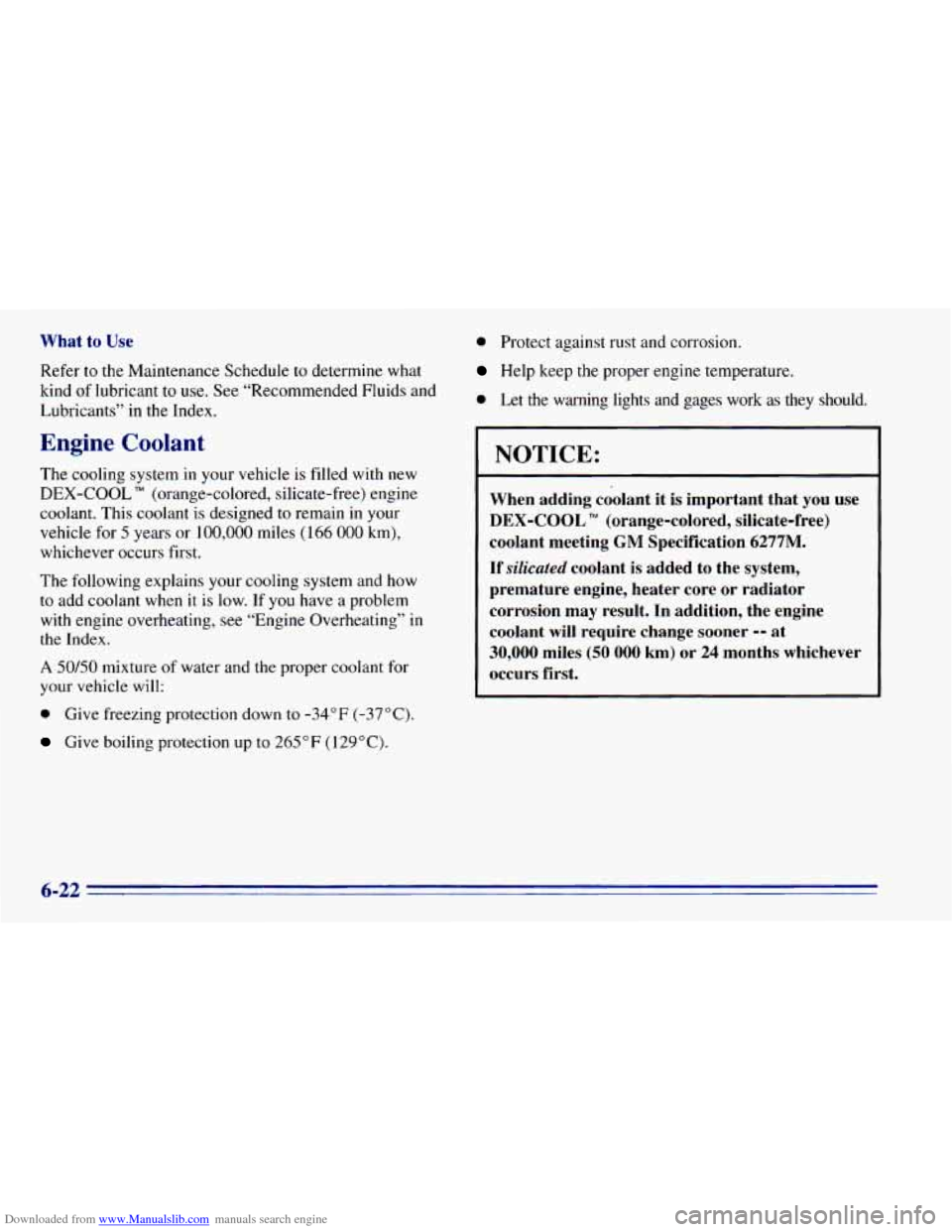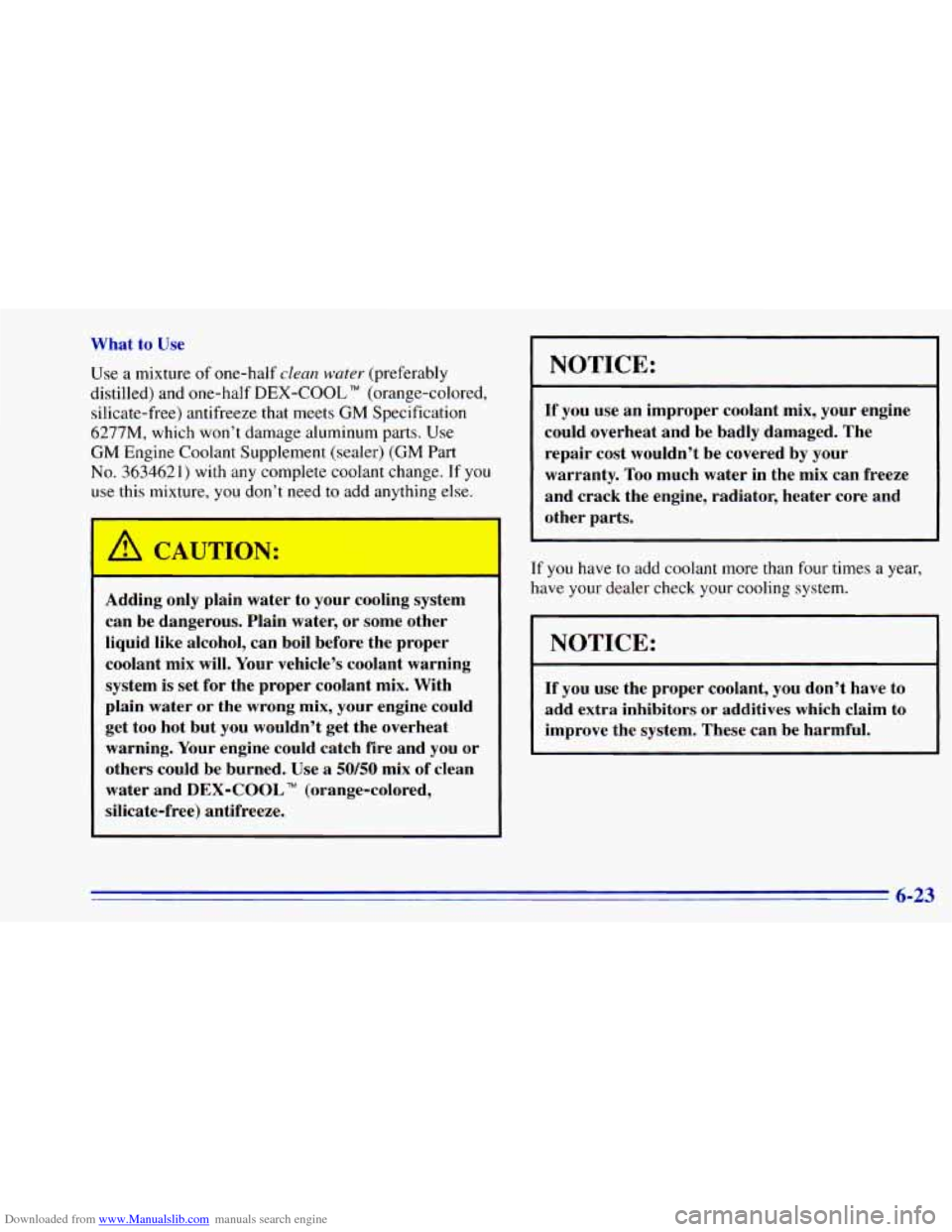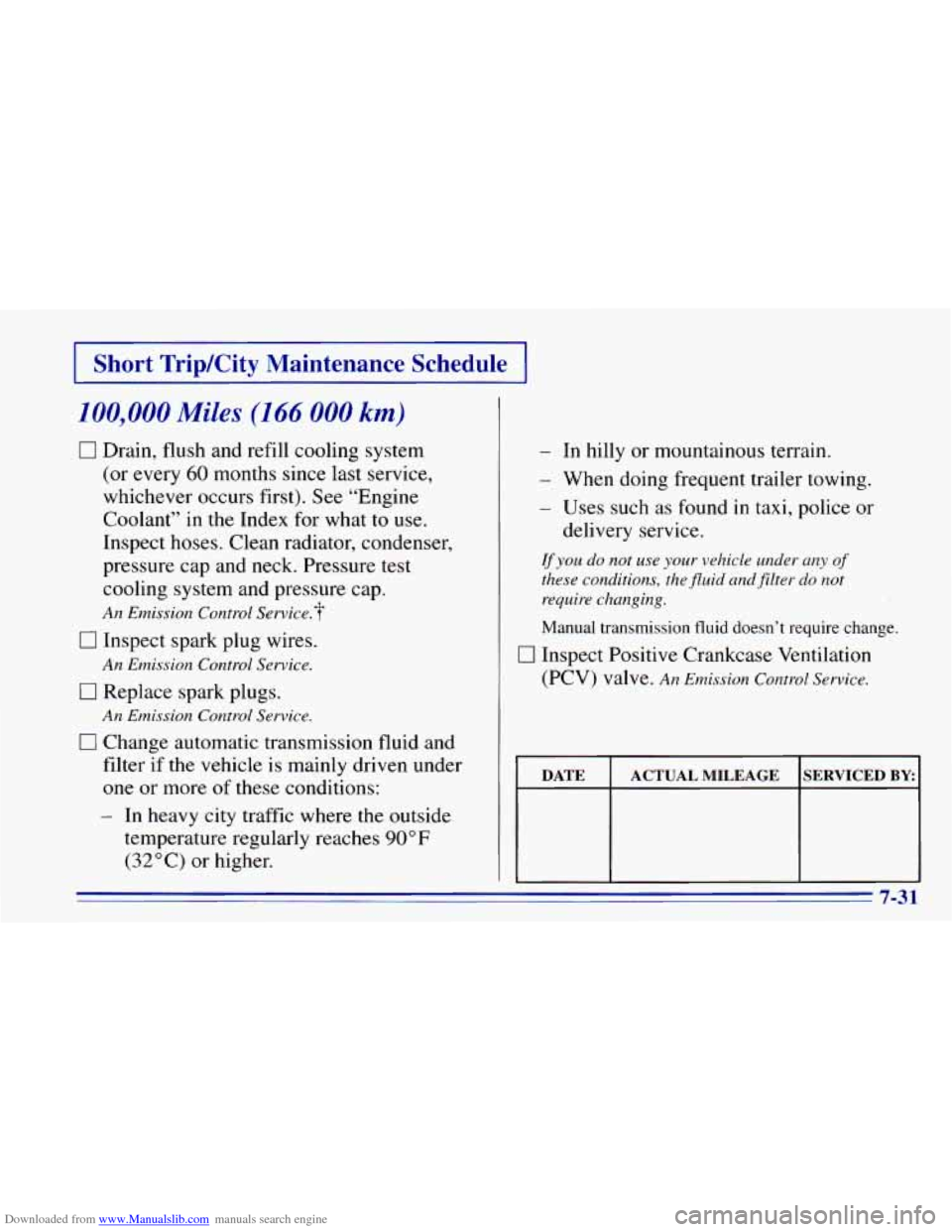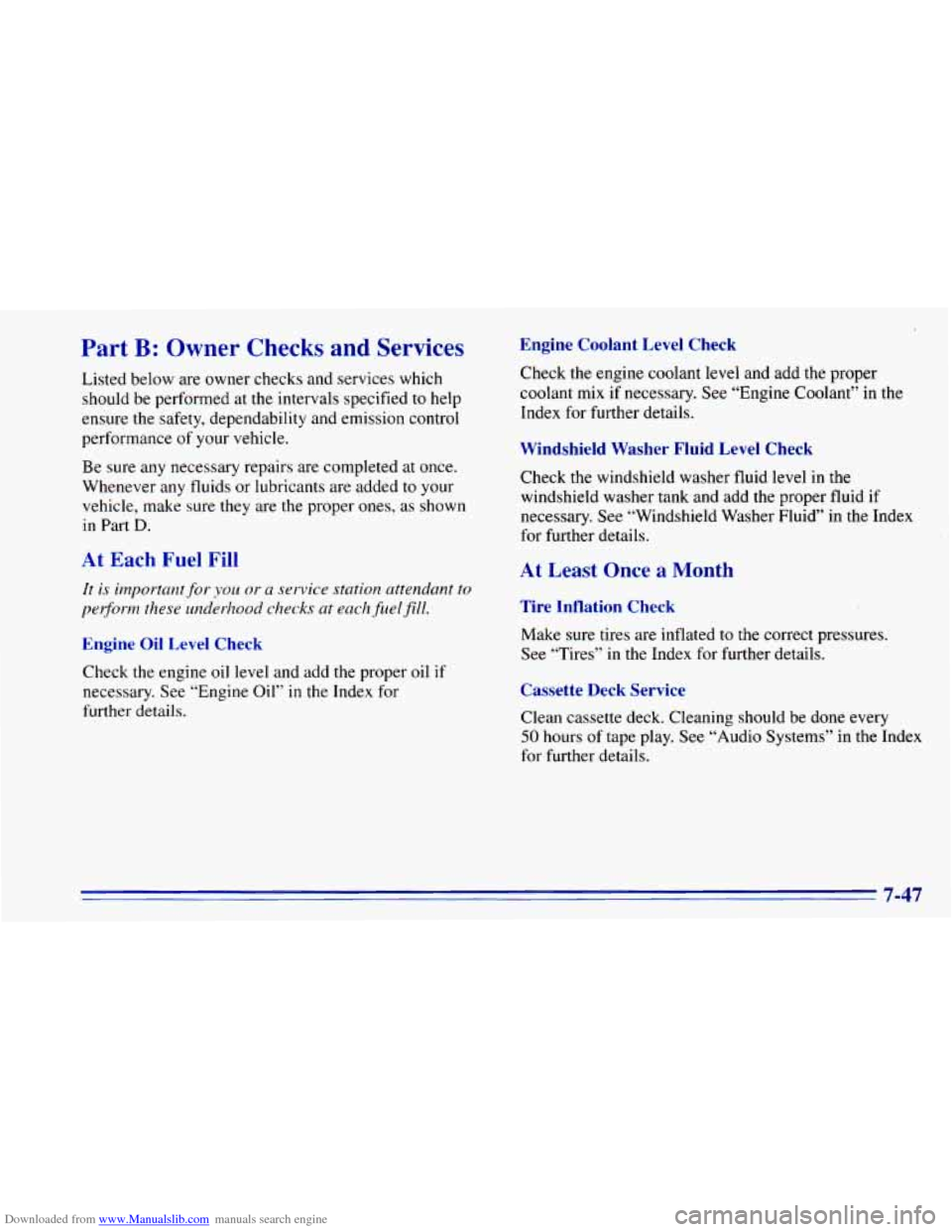Page 270 of 392

Downloaded from www.Manualslib.com manuals search engine What to Use
Refer to the Maintenance Schedule to determine what
kind of lubricant to use. See “Recommended Fluids and
Lubricants” in the Index.
Engine Coolant
The cooling system in your vehicle is filled with new
DEX-COOL TM (orange-colored, silicate-free) engine
coolant. This coolant is designed to remain
in your
vehicle for
5 years or 100,000 miles (166 000 km),
whichever occurs first.
The following explains your cooling system and how
to add coolant when
it is low. If you have a problem
with engine overheating, see “Engine Overheating” in
the Index.
A 50/50 mixture of water and the proper coolant for
your vehicle will:
0 Give freezing protection down to -34°F (-37 “C).
Give boiling protection up to 265 “F (129°C).
0 Protect against rust and corrosion.
Help keep the proper engine temperature.
0 Let the warning lights and gages work as they should.
I 1
NOTICE:
When adding coolant it is important that you use
DEX-COOL TM (orange-colored, silicate-free)
coolant meeting
GM Specification 6277M.
If silicated coolant is added to the system,
premature engine, heater core or radiator
corrosion may result. In addition, the engine coolant
will require change sooner -- at
30,000 miles (50 000 km) or 24 months whichever
occurs first.
6-22
Page 271 of 392

Downloaded from www.Manualslib.com manuals search engine What to Use
Use a mixture of one-half
clean water (preferably
distilled) and one-half DEX-COOL
TM (orange-,colored,
silicate-free) antifreeze that meets
GM Specification
6277M, which won’t damage aluminum parts. Use
GM Engine Coolant Supplement (sealer) (GM Part
No. 3634621) with any complete coolant change. If you
use this mixture, you don’t need
to add anything else.
L
Adding only plain water to your cooli,,g system
can be dangerous. Plain water, or some other liquid like alcohol, can boil before the proper
coolant mix
will. Your vehicle’s coolant warning
system is set for the proper coolant mix. With
plain water or the wrong mix, your engine could
get too hot but you wouldn’t get the overheat
warning. Your engine could catch fire and you or
others could be burned. Use
a 50/50 mix of clean
water and
DEX-COOL TM (orange-colored.
silicate-free) antifreeze.
NOTICE:
If you use an improper coolant mix, your engine
could overheat and be badly damaged. The
repair cost wouldn’t be covered by your
warranty.
Too much water in the mix can freeze
and crack the engine, radiator, heater core and
other parts.
If you have to add coolant more than four times a year,
have your dealer check your cooling system.
NOTICE:
If you use the proper coolant, you don’t have to
add extra inhibitors or additives which claim to
improve the system. These can be harmful.
6-23
Page 272 of 392
Downloaded from www.Manualslib.com manuals search engine Checking Coolant
When your engine is cold, the coolant level should be at
ADD, or a little higher. When your engine is warm, the
level should be up
to FULL HOT, or a little higher.
Adding Coolant
If you need more coolant, add
the proper mix at the
coolant
recovery tank.
A CAUTION:
I--
lbrning the radiator pressure cap when the
engine and radiator are hot can allow steam
and scalding liquids to blow out and burn you
badly. With the coolant recovery tank, you will
almost never have to add coolant at the radiator.
Never turn the radiator pressure cap
-- even a
little -- when the engine and radiator are hot.
Add coolant mix at the recovery tank, but be careful not
to spill it.
A CAUTION:
You can be burned if you spill coolant on hot
engine parts. Coolant contains ethylene glycol,
and it will
burn if the engine parts are hot
enough. Don’t spill coolant on a hot engine.
6-24
Page 273 of 392
Downloaded from www.Manualslib.com manuals search engine ’ Radiator Pressure Cap
NOTICE:
Your radiator cap is a 15 psi (105 kPa)
pressure-type cap and must be tightly installed to
prevent coolant
loss and possible engine damage
from overheating. Be sure the arrows on the cap line up with the overflow tube on the radiator
filler neck.
Thermostat
Engine coolant temperature is controlled by a thermostat
in the engine coolant system. The thermostat stops the
flow of coolant through the radiator until the coolant
reaches a preset temperature.
6-25
Page 343 of 392

Downloaded from www.Manualslib.com manuals search engine Short Trip/City Maintenance Schedule
100,000 Miles (166 000 km)
0 Drain, flush and refill cooling system
(or every
60 months since last service,
whichever occurs first). See “Engine
Coolant”
in the Index for what to use.
Inspect hoses. Clean radiator, condenser,
pressure cap and neck. Pressure test
cooling system and pressure cap.
An Emission Control Service. 3-
0 Inspect spark plug wires.
0 Replace spark plugs.
0 Change automatic transmission fluid and
filter
if the vehicle is mainly driven under
one or more of these conditions:
An Emission Control Service.
An Emission Control Service.
- In heavy city traffic where the outside
temperature regularly reaches
90 OF
(32°C) or higher.
- In hilly or mountainous terrain.
- When doing frequent trailer towing.
- Uses such as found in taxi, police or
delivery service.
Ifyou do not use your vehicle under any of
these conditions, the fluid andjilter do not
require changing.
Manual transmission fluid doesn’t require change.
0 Inspect Positive Crankcase Ventilation
(Pcv) valve.
An Emission Control Service.
7-31
Page 357 of 392
Downloaded from www.Manualslib.com manuals search engine I Long Tripmighway Maintenance Schedule I
0 Check readfront axle fluid level ana aaa
fluid as needed. Check constant velocity
joints and axle seals for leaking.**
0 Rotate tires. See “Tire Inspection and
Rotation” in the Index for proper rotation
pattern and additional information. During
tire rotation, check brake calipers for
freedom of movement. Refer
to the
appropriate
GM service manual for proper
caliper service procedures.
DATE ACTUAL MILEAGE SERVICED BY
100,000 Miles (1 66 000 km)
0 Drain, flush and refill cooling system
(or every
60 months since last service,
whichever occurs first). See “Engine
Coolant’’ in
the Index for what to use.
Inspect hoses. Clean radiator, condenser,
pressure cap and neck. Pressure test the
cooling system and pressure cap.
An Emission Control Service.
0 Inspect spark plug wires.
0 Replace spark plugs.
An Emission Control Service.
An Emission Control Service.
(Continued)
7-45
Page 359 of 392

Downloaded from www.Manualslib.com manuals search engine Part B: Owner Checks and Services
Listed below are owner checks and services which
should be performed at the intervals specified to help
ensure the safety, dependability and emission control
performance of your vehicle.
Be sure any necessary repairs are completed at once.
Whenever any fluids or lubricants are added to your
vehicle, make sure they are the proper ones, as shown
in Part D.
At Each Fuel Fill
It is important for you or a service station attendant to
perform these underhood checks
at each fuel fill.
Engine Oil Level Check
Check the engine oil level and add the proper oil if
necessary. See “Engine Oil” in the Index for
further details.
Engine Coolant Level Check
Check the engine coolant level and add the proper
coolant mix if necessary. See “Engine Coolant” in the
Index for further details.
Windshield Washer Fluid Level Check
Check the windshield washer fluid level in the
windshield washer tank and add the proper fluid if
necessary. See “Windshield Washer Fluid” in the Index
for further details.
At Least Once a Month
Tire Inflation Check
Make sure tires are inflated to the correct pressures.
See “Tires”
in the Index for further details.
Cassette Deck Service
Clean ca :tte deck. Cleaning should be done every
50 hours or tape play. See “Audio Systems” in the Index
for further details.
7-47
Page 365 of 392

Downloaded from www.Manualslib.com manuals search engine Part D: Recommended Fluids and
Lubricants
NOTE: Fluids and lubricants identified below by name,
part number or specification may be obtained from your
GM dealer.
USAGE
Engine Oil
Engine Coolant
FLUIDLUBRICANT
Engine oil with the American
Petroleum Institute Certified For
Gasoline Engines “Starburst”
symbol
of the proper viscosity. To
determine the preferred viscosity
for your vehicle’s engine, see
“Engine Oil”
in the Index.
50/50 mixture of clean water
(preferably distilled) and GM
Goodwrench@ DEX-COOL
TM or
Havoline@
DEX-COOL TM
(orange-colored, silicate-free)
antifreeze. conforming
to GM
Specification 6277M. See “Engine
Coolant’‘
in the Index.
USAGE
Coolant
Supplement
Sealer
Hydraulic Brake
System
Hydraulic Clutch
System
Parking Brake
Cable Guides
Power Steering
System
Manual
Transmission
FLUIDLUBRICANT
GM Part No. 3634621 or
equivalent with a complete flush
and
refi 11.
Delco Supreme I 1 @ Brake Fluid
(GM Part
No. 1052535 or
equivalent DOT-3 brake fluid).
Hydraulic Clutch Fluid (GM Part
No. 12345347 or equivalent).
Chassis lubricant (GM Part
No. 1052497 or equivalent) or
lubricant meeting requirements
of
NLGI Grade 2, Category LB
or GC-LB.
GM Power Steering Fluid (GM
Part
No. 1052884 - 1 pt.,
1050017
- 1 qt., or equivalent).
Synchromesh Transmission Fluid
(GM Part
No. 12345349 or
equivalent).
7-53